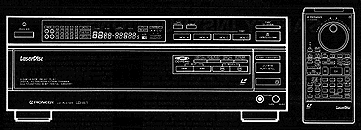



 This "artists concept" image of the LD-W1 was scanned from the cover of the owners manual. But don't be fooled by
its appearance. This 2-disc, 4-sided LaserDisc only player is one of the most forgiving solid-state players I've
run across for playing DiscoVision discs. Experience with this player varies wildly as some have complained about
a rash of early life failures and general noisy picture. The unit used as a basis for this article has been in
use since July of 1988 and it has never failed to produce a stunning picture from almost any disc.
This "artists concept" image of the LD-W1 was scanned from the cover of the owners manual. But don't be fooled by
its appearance. This 2-disc, 4-sided LaserDisc only player is one of the most forgiving solid-state players I've
run across for playing DiscoVision discs. Experience with this player varies wildly as some have complained about
a rash of early life failures and general noisy picture. The unit used as a basis for this article has been in
use since July of 1988 and it has never failed to produce a stunning picture from almost any disc.
One of the major advantages to the LD-W1 is its speckle rejection noise reduction. Even with the digital field memory disabled (the LD-W1 and CLD-3030 were the first non-Elite players to feature Digital Memory), the player can effectively eliminate all but the most stubborn speckles from a video image. In "Still Frame" mode, the system is not as effective, and individual speckles are more prevalent, but the results in playback are outstanding.
On startup, the player will always search for frame 0 for CAV and minute 0 on CLV/CAA discs. On DiscoVision discs, this usually begins playback about half way through the DiscoVision opening logo. The auto-reverse feature performs side changes in 12-15 seconds, and begins each side at the proper place. When searching, the player will usually catch the end of side signal on DiscoVision, but it is possible to search beyond the end of the side.
The LD-W1 has the ability to learn how to play discs it does not recognize. This is especially good in when trying to play side 2 of The Bionic Woman or any of the General Motors discs. The player will spin the disc up and then sound like it is grinding away at the surface. It's really just the pickup searching back and forth, trying to analyze where the sync signal is on the disc. After about 20 seconds, the player will drop into playback, but rarely at the first frame. This is especially handy because the "beginning of side" frame 0 signal will be ignored and you can scan all the way to the inner-limit setting of the player. Since GM discs do not include the Philips code, you will not be able to pause, freeze-frame, search or allow the disc to try and "auto-reverse".
One of the big limitations of the LD-W1 is the solid state laser pickup assembly. While it's great for playing the discs produced today, it does have a slight problem tracking some of the older DiscoVision discs. This give the player the tendency to Laserlock. It's as though the beam is trying to read a pit structure where the tracks are too close together, and getting confused as to which track it should be reading. I'm not saying this is the problem, but that is how it appears. This is a problem not exclusive to the LD-W1, but to all LaserDisc players manufactured since 1984.
Audio reproduction could also be considered a weak point. Since most manufacturers are focusing on Digital audio, Dolby Digital (AC-3) and DTS Digital Surround, analog audio has taken a bit of a back seat. While not as troublesome in this 1988 player compared to newer ones, it still does not have the fidelity by comparison to the Gas Tube players discussed elsewhere on this web site. Some of the DiscoVision discs contain a minor carrier shift in the audio which creates huge amounts of static which may be reduced as the disc plays. One might dismiss this as a simple defect in the disc, but when the same disc is played in an older top-loading gas tube unit, the audio is much quieter.
| Advantages | Disadvantages | ||||||
|---|---|---|---|---|---|---|---|
|
|
Updated: November 17, 1998
Copyright ©1998 Blam Entertainment Group